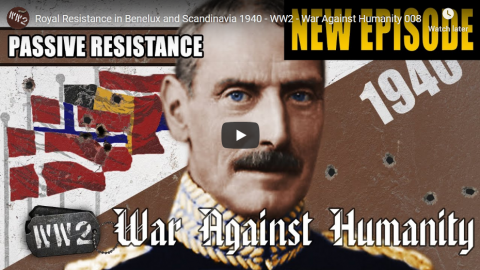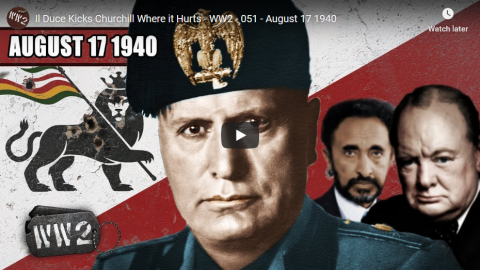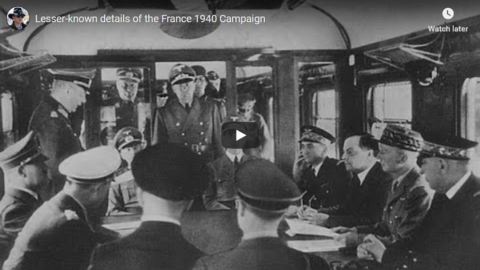Forgotten Weapons
Published 20 Oct 20230:00 Introduction and Overview of the AFN 49
1:23 Detailed Insight into the AFN 49’s Global Presence
3:01 Demonstration and Explanation of the AFN’s Unique Features
5:05 Auto Trip Feature: A Deep Dive
7:27 Unique Characteristics of the AFN 49
8:48 The Journey of AFN 49s to the US
10:17 Conversion of Luxembourg AFN 49s: A Historical Perspective
10:43 Conclusion and AcknowledgementsA note to censors: This video is not a tutorial on full auto conversion. It is an explanation of how the system works, and provides no instruction of how to fabricate or modify parts to modify a semiautomatic firearm into a fully automatic one. Doing that would be illegal for most people — although certainly not all; conversion or ownership of machine guns is legal in most places with the appropriate government permission.
The SAFN, aka FN-49, is one of the classic post-war European battle rifles, and was sold to nine different countries in the early 1950s before the FAL became FN’s primary combat rifle offering. What is often forgotten is that despite being limited to a fixed 10-round magazine, nearly half of all FN-49s produced were actually fully automatic AFN-49s. The Belgian Army, Luxembourg Army, Luxembourg Gendarmerie, and Belgian Congo all purchased the automatic pattern. So today, we’re going to take a look at how it differs from the regular SAFN that we are used to seeing.
Interestingly, a batch of the Luxembourg Gendarmerie rifles were imported into the US without anyone realising that they were automatic until they arrived and were being unpacked. InterArms went to the IRS (the NFA was a tax law administered by the Treasury; this was before the formation of the ATF) and proposed removing the selector levers and auto sears, as well as milling off their attachment points on the receivers. The IRS agreed that this would be an acceptable conversion to render the guns legally semiautomatic only, and the changes were made before the rifles were sold. They remain on the US collector market today as an interesting example of legal conditions prior to the adoption of a pointless and punitive decree of “once a machine gun, always a machine gun”.
Many thanks to the Royal Museum of the Armed Forces and Military History in Brussels for access to this very cool piece! Check them out here: https://www.klm-mra.be/en/
(more…)
January 27, 2024
AFN-49: The Forgotten Full-Auto Brother of the FN-49
December 24, 2023
The Siege of Bastogne Begins – WW2 – Week 278 – December 23, 1944
World War Two
Published 23 Dec 2023The German Ardennes Offensive, called by the Allies the Battle of the Bulge, is in full swing in Luxembourg and Belgium this week, and the Germans have the key junction town of Bastogne under siege. On the Allied side there comes a large American surrender, plans for counterattacks, and tension growing between British and American Commands. The fight in both Italy and the Philippines continues, and in Hungary the Soviets have nearly surrounded Budapest.
00:26 Intro
01:06 The Battle of the Bulge
03:54 The Malmedy Massacre
06:25 Bastogne
10:00 American Surrender on Schnee Eifel
12:06 Patton plans a counterattack
15:44 Bernard Montgomery and Omar Bradley
18:12 The Red Army advances around Budapest
21:39 Fighting in Italy and Greece
22:45 Leyte and Mindoro
25:07 Conclusion
(more…)
October 22, 2022
Battle of the Bulge 1944: Could the German Plan Work?
Real Time History
Published 21 Oct 2022Sign up for Nebula and watch Rhineland 45: https://nebula.tv/realtimehistory
The Battle of the Bulge was one of the last German offensives during the Second World War. It caught the US Army off guard in the Ardennes sector but ultimately the Allies prevailed. But did Unternehmen Wacht am Rhein (“Operation Watch on the Rhine”) ever have a chance to succeed and reach Antwerp?
(more…)
October 4, 2022
Sweden: The Jews’ Salvation? – WAH 080 – October 2, 1943
World War Two
Published 2 Oct 2022As the Allies advance in southern Italy, the people of Naples join them in fighting the Wehrmacht. In Denmark, the biggest rescue operation of Jews thus far begins.
(more…)
July 19, 2021
Luxembourg FN49 Semiauto Sniper Rifle
Forgotten Weapons
Published 30 Jan 2019http://www.patreon.com/ForgottenWeapons
Cool Forgotten Weapons merch! http://shop.bbtv.com/collections/forg…
After World War Two, Luxembourg was one of the nations which opted to purchase new FN-49 rifles. It bought a total of 6,203 of them for the military — an initial purchase of 4,000 semiauto SAFN rifles and a followup purchase of 2,000 AFN select-fire rifles and 203 semiauto rifles fitted with Belgian OIP telescopic sights. The scope mounts were commercial Echo mounts, designed and manufactured by an American engineer named Herkner, in Boise Idaho.
When Luxembourg replaced its FN49 rifles with the newer FN FAL type, the snipers were either scrapped or sold as surplus, but the scopes were kept and reused on FALs. However, the Luxembourg rifles used the same pattern OIP scopes as the Belgian military, and these are often found mounted to surviving Luxembourg rifles.
Contact:
Forgotten Weapons
PO Box 87647
Tucson, AZ 85754
February 22, 2021
The Best BAR: Luxembourg .30-06 FN-D at the Range
Forgotten Weapons
Published 17 Nov 2020http://www.patreon.com/ForgottenWeapons
https://www.floatplane.com/channel/Fo…
Cool Forgotten Weapons merch! http://shop.bbtv.com/collections/forg…
I normally want to have something specific to demonstrate when I take a gun to the range, but today I don’t. What I have today is and FN-D, the very best iteration of the Browning Automatic Rifle (BAR) — and I just wanted an excuse to take it out to enjoy. Specifically, this is a Luxembourg contract FN-D chambered for .30-06. So, please pardon my flimsy excuse, and enjoy!
Contact:
Forgotten Weapons
6281 N. Oracle #36270
Tucson, AZ 85740
November 28, 2020
FN Model D: The Last and Best BAR
Forgotten Weapons
Published 21 Aug 2020http://www.patreon.com/ForgottenWeapons
https://www.floatplane.com/channel/Fo…
Cool Forgotten Weapons merch! http://shop.bbtv.com/collections/forg…
Contact:
Forgotten Weapons
6281 N. Oracle #36270
Tucson, AZ 85740
February 18, 2020
Royal Resistance in Benelux and Scandinavia 1940 – WW2 – War Against Humanity 008
World War Two
Published 17 Feb 2020When the Racism of Naziism hits the Nationalism of Monarchism, it doesn’t quite go like Hitler would have imagined.
Join us on Patreon: https://www.patreon.com/TimeGhostHistory
Or join The TimeGhost Army directly at: https://timeghost.tvFollow WW2 day by day on Instagram @World_war_two_realtime https://www.instagram.com/world_war_t…
Join our Discord Server: https://discord.gg/D6D2aYN.
Between 2 Wars: https://www.youtube.com/playlist?list…
Source list: http://bit.ly/WW2sourcesWritten and Hosted by: Spartacus Olsson
Produced and Directed by: Spartacus Olsson and Astrid Deinhard
Executive Producers: Bodo Rittenauer, Astrid Deinhard, Indy Neidell, Spartacus Olsson
Creative Producer: Joram Appel
Post-Production Director: Wieke Kapteijns
Research by: Spartacus Olsson
Edited by: Mikołaj Cackowski
Map animations: Eastory (https://www.youtube.com/c/eastory)Colorizations by:
Norman Stewart – https://oldtimesincolor.blogspot.com/
Julius Jääskeläinen – https://www.facebook.com/JJcolorization/
Sources:
National Museum of Denmark https://natmus.dk/museer-og-slotte/fr…
Archive of I.M. Bondarenko
Regionaal Archief Nijmegen
CegeSoma, n°34706
NationalSocialistMovementintheNetherlands (1).png by Ec1801011 from wikimedia commons https://commons.wikimedia.org/wiki/Fi…
Resistance_15_December_1940 by SiefkinDR from wikimedia commons https://en.wikipedia.org/wiki/File:Re…
IWM (FL 24877, HU 66187)
The Dubbo Liberal and Macquarie Advocate (NSW : 1894 – 1954), p. 3 http://nla.gov.au/nla.news-article132…
Yousuf Karsh, National Archives of the Netherlands / Fotocollectie Anefo
Narodowe Archiwum Cyfrowe
Delphin, Rigmor Dahl, Oslo MuseumSoundtracks from the Epidemic Sound:
Johannes Bornlof – “Deviation in Time”
Farrell Wooten – “Blunt Object”
Wendel Scherer – “Reunion”
Fabien Tell – “Last Point of Safe Return”
Howard Harper-Barnes – “London”
Hakan Eriksson – “The End of The World 2”
Phoenix Tail – “At the Front”Archive by Screenocean/Reuters https://www.screenocean.com.
A TimeGhost chronological documentary produced by OnLion Entertainment GmbH.
From the comments:
Spartacus Olsson
3 days ago
You’d think that the Nazis would know how nationalism works … well, it turns out that when Hitler’s fantasies of race meet the very real nationalism of the old European monarchies, race doesn’t have the trump. Now, in 1940 nationalism isn’t that old, but it’s anchored in old traditions that the monarchies now occupied by the Nazis have managed to reconcile with modernity rather successfully. And here’s an important point: nationalism is often decried as the root of all of these conflicts, and perhaps it is, but in some places it’s also proved to be fertile ground for modern democracy. Perhaps there’s a lesson to be learnt somewhere in there, and maybe that’s that in the end it’s not what, but how that makes a difference. What’s particularly interesting, in for instance the Netherlands with the February Strike or in the Germany resistance rings, is that when faced with a common enemy to the nation, patriotism unites people across the political spectrum, well except those obsessed with the idea of race.
September 27, 2019
England’s constitution before the shiny new Supreme Court was created
Peter Hitchins provides a thumbnail sketch of the state of play before the Supreme Court was added to British constitutional arrangements:

“Palace of Westminster” by michaelhenley is licensed under CC BY-NC-SA 2.0
Why did we never even have such a body until ten years ago? As we shall see, it would have been, and still is, a contradiction in terms. But in interesting times such as these, elephants fly, fishes walk, figs grow on thorns, and oxymorons inherit the earth.
The most powerful law court in the land was, by a curious paradox, not in the land at all, but based in tiny Luxembourg, across the Narrow Seas which have kept invaders from our door but are useless against bureaucratic takeovers by the European Union. There sits the European Court of Justice, which as long ago as 1990 established that it could tell British courts to overrule British Acts of Parliament when they conflict with E.U. law. It can carry on doing this until we eventually do leave the E.U., if we ever do.
These various messes came about because we are so old, and rely so much on convention and manners, that it is all too easy for unconventional and ill-mannered busybodies to come storming in with new ideas. England’s constitution was not planned and built, like America’s. Instead, it grew during a thousand years of freedom from invasion. Both are beautiful in their way. America’s fundamental law has the cold, orderly beauty of a classical temple. England’s has the warmer, more chaotic loveliness of an ancient forest. It seems to be wholly natural but, when examined closely, it shows many signs of careful cultivation and pruning. Our powers are not as separated as America’s, but slightly tangled. Still, it has worked well enough for us over time.
Any thinking person must admire both the American and the English constitutions as serious efforts in a world of chaos, despotism, and stupidity to apply human intelligence to the task of giving people ordered, peaceful, and free lives. They have a common origin in the miraculous Magna Carta, which Americans often revere more than modern Englishmen do. We in England have grown complacent about our liberty, and have become inclined to forget our great founding documents.
But the two constitutions are not the same, and in my view they are not compatible. For my whole life, until a few years ago, the very idea that England should have a Supreme Court was an absurdity. The Highest Court in England is the Crown in Parliament which, as I was once taught, had the power to do everything except turn a man into a woman. In these more gender-fluid times, that expression is not much used. But it contains the truth. Parliament can make any law and overturn any law, made by itself or by the courts.
That is why England (often to my regret) lacks a First Amendment and cannot have one unless we undergo a revolution. No law in England could possibly open with the words “Parliament shall make no law.” Our 1689 Bill of Rights, the model for the U.S. Bill of Rights a century later, tells the king what he cannot do and the courts what they cannot do. It grants me (as a Protestant) the right to have weapons for my defense. But while it draws its sword against arbitrary power, it puts a protective arm round Parliament.
August 18, 2019
Il Duce Kicks Churchill Where it Hurts – WW2 – 051 – August 17 1940
World War Two
Published on 17 Aug 2019As the Battle of Britain reaches not seen before levels of intensity, one of the British colonies is lost to the Italians.
Join us on Patreon: https://www.patreon.com/TimeGhostHistory
Or join The TimeGhost Army directly at: https://timeghost.tvFollow WW2 day by day on Instagram @World_war_two_realtime https://www.instagram.com/world_war_t…
Join our Discord Server: https://discord.gg/D6D2aYN.
Between 2 Wars: https://www.youtube.com/playlist?list…
Source list: http://bit.ly/WW2sourcesWritten and Hosted by: Indy Neidell
Produced and Directed by: Spartacus Olsson and Astrid Deinhard
Executive Producers: Bodo Rittenauer, Astrid Deinhard, Indy Neidell, Spartacus Olsson
Creative Producer: Joram Appel
Post-Production Director: Wieke Kapteijns
Research by: Indy Neidell
Edited by: Iryna Dulka
Map animations: EastoryColorisations by Norman Stewart and Julius Jääskeläinen https://www.facebook.com/JJcolorization/
Eastory’s channel: https://www.youtube.com/channel/UCEly…
Archive by Screenocean/Reuters https://www.screenocean.com.Sources:
– Banda groups scan by Localcivis
– Freepngimg.com
– Original photograph of Simon Gauleiter by Mykemalone on Wikimedia Commons
– Membership card photo Photograph by Zinneke on Wikimedia Commons
– IWM: E 1168, E 4350, NA 1670A TimeGhost chronological documentary produced by OnLion Entertainment GmbH.
June 28, 2019
Lesser-known details of the France 1940 Campaign
The_Chieftain
Premiered on 22 Jun 2019Your friendly history lesson, with a little bit of Op-Ed thrown in, some parts of the 1940 campaign in France of which many folks weren’t aware.
Why was Guderian relieved of command?
Why might condoms have changed the course of the war?
What’s a Niwi?
Was the French failure one of doctrine, or execution?
You get the idea.Patreon link here:
https://www.patreon.com/The_ChieftainWorld War Two channel, if you haven’t already found it… : https://www.youtube.com/channel/UCP1A…
May 19, 2019
The German Breakthrough in the West – WW2 – 038 – May 18 1940
World War Two
Published on 18 May 2019The German invasion of Western Europe has been going for over a week now, and the Neutral and Allied countries are in disarray. The Netherlands, despite putting up fierce resistance on some occasions, faces overwhelming powers while Belgium, France and the British feel the pressure from an organised and armoured assault from the Ardennes. And still, the German tanks, soldiers and aircraft are not all the Allies have to fear, as many of their losses are caused by their own command.
Join us on Patreon: https://www.patreon.com/TimeGhostHistory
Or join The TimeGhost Army directly at: https://timeghost.tvChurchills ‘Blood, toil, tears and sweat’ speech: https://winstonchurchill.org/resource…
Follow WW2 day by day on Instagram @World_war_two_realtime https://www.instagram.com/world_war_t…
Join our Discord Server: https://discord.gg/D6D2aYN.
Between 2 Wars: https://www.youtube.com/playlist?list…
Source list: http://bit.ly/WW2sourcesWritten and Hosted by: Indy Neidell
Produced and Directed by: Spartacus Olsson and Astrid Deinhard
Executive Producers: Bodo Rittenauer, Astrid Deinhard, Indy Neidell, Spartacus Olsson
Creative Producer: Joram Appel
Research by: Indy Neidell
Post-Production Director: Wieke Kapteijns
Edited by: Iryna Dulka
Map animations: EastoryColorisations by Norman Stewart and Julius Jääskeläinen https://www.facebook.com/JJcolorization/
Eastory’s channel: https://www.youtube.com/channel/UCEly…
Archive by Screenocean/Reuters https://www.screenocean.com.Sources:
– © IWM (C 1666)A TimeGhost chronological documentary produced by OnLion Entertainment GmbH.
From the comments:
World War Two
This is the longest weekly episode of our World War Two series to this date, and boy are we proud. We made sure to make this the absolute best it could possibly be. After last week’s episode of WW2, it was hard to imagine that Eastory could surpass his efforts for that episode anytime soon, but it took him one week. Iryna, our editor in Warsaw, did an amazing job with putting together this episode. We hope you like it as much as we do. Thanks for your ongoing support and if you don’t already, please consider supporting us on Patreon.By the way, we have an Instagram feed where we dedicate one post per day of the war, which allows us to give some topics a little more attention, like the invasion of the Netherlands. You can check them out here:
11 May 1940 – Germans attack Dutch positions on the Grebbeberg and the Grebbeline: https://www.instagram.com/p/BxVBQcwnHAs/
12 May 1940 – Three German Panzer divisions approach Sedan to Force a breakthrough into France: https://www.instagram.com/p/BxYS8XqHdTh/
13 May 1940 – The Battle of the Grebbeberg ends in a German victory, allowing them to push into Holland: https://www.instagram.com/p/Bxauq9HnqOW/
14 May 1940 – German bombers destroy the inner city of Rotterdam while peace talks are going on: https://www.instagram.com/p/Bxc7zreiXo8/
15 May 1940 – The French fight a successful but practically meaningless battle at Gembloux: https://www.instagram.com/p/BxfGP1qCzV9/
16 May 1940 – Guderian rapidly moves westward, showing the full potential of tank-warfare: https://www.instagram.com/p/BxhxvyDClbY/
December 12, 2014
QotD: Apple isn’t worth the same as Switzerland
It is true that Switzerland’s GDP is around $700 billion. But GDP is a measure of value added in a country in one year. That is, it’s the income of the place. Apple’s $700 billion valuation is the total value of the company: this is akin to wealth, not income. And of course the value of a stock is the net present value of all of the future income from it. So, that $700 billion for Apple is the current value (as the market estimates it) of everything that Apple will ever do in the future. The valuation of Switzerland, that $700 billion, is what the place made this year alone. Two very different numbers.
To get to something comparable for Apple we need to work out this year’s added value. A rough and ready definition of that is profits plus wages paid (this is approximately equal to the labour and profit shares in GDP which don’t quite equal total GDP but good enough for rough comparisons). Apple’s profits are around $40 billion, it employs a little under 100,000 people directly. Say each of those is paid $100,000 a year (obviously, some get very much more but when we add in the Genius Bar folks that might be reasonable enough as an average) which gives us another $10 billion. Not entirely accurate but reasonable enough to say that Apple’s value add, the equivalent of GDP, is some $50 billion.
When we go looking for a country at around that we find The Sudan and Luxembourg jointly on some $55 billion. And Luxembourg is some 400,000 people, and roughly half of the people in a country work (take out the kiddies, pensioners, housewives etc, roughly correct) giving us a Luxembourgois workforce of 200,000 people. 100,000 people in one of the most profitable companies on the planet produce about the same value as 200,000 rich world people in a country. OK, that’s impressive for Apple but it’s a much better indication of the company’s economic size than any other measure. It is, around and about, fair to say that Apple produces the same economic value as Luxembourg. […]
And to repeat the point at the top, we’re never going to really understand corporate power or the size of the corporate sector (or corporations) until we start to understand what these different numbers being bandied about as valuations and value of production etc really mean. Corporations really are very much smaller than countries: even the largest and most valuable of corporations is really only comparable to a city sized country. To give you a much better idea of the size of Apple relative to economic output of an area then Apple’s about the size of Raleigh, North Carolina, Omaha Nebraska, maybe, just maybe as large as Forth Worth, Texas, or Charlotte, North Carolina. Somewhere in that range at least. Or to use States, perhaps around Rhode Island or Maine.
Corporations just aren’t as large and economically powerful as some seem to think.
Tim Worstall, “Apple Isn’t Worth Switzerland But It Is Worth All The World’s Airlines”, Forbes, 2014-11-22.









